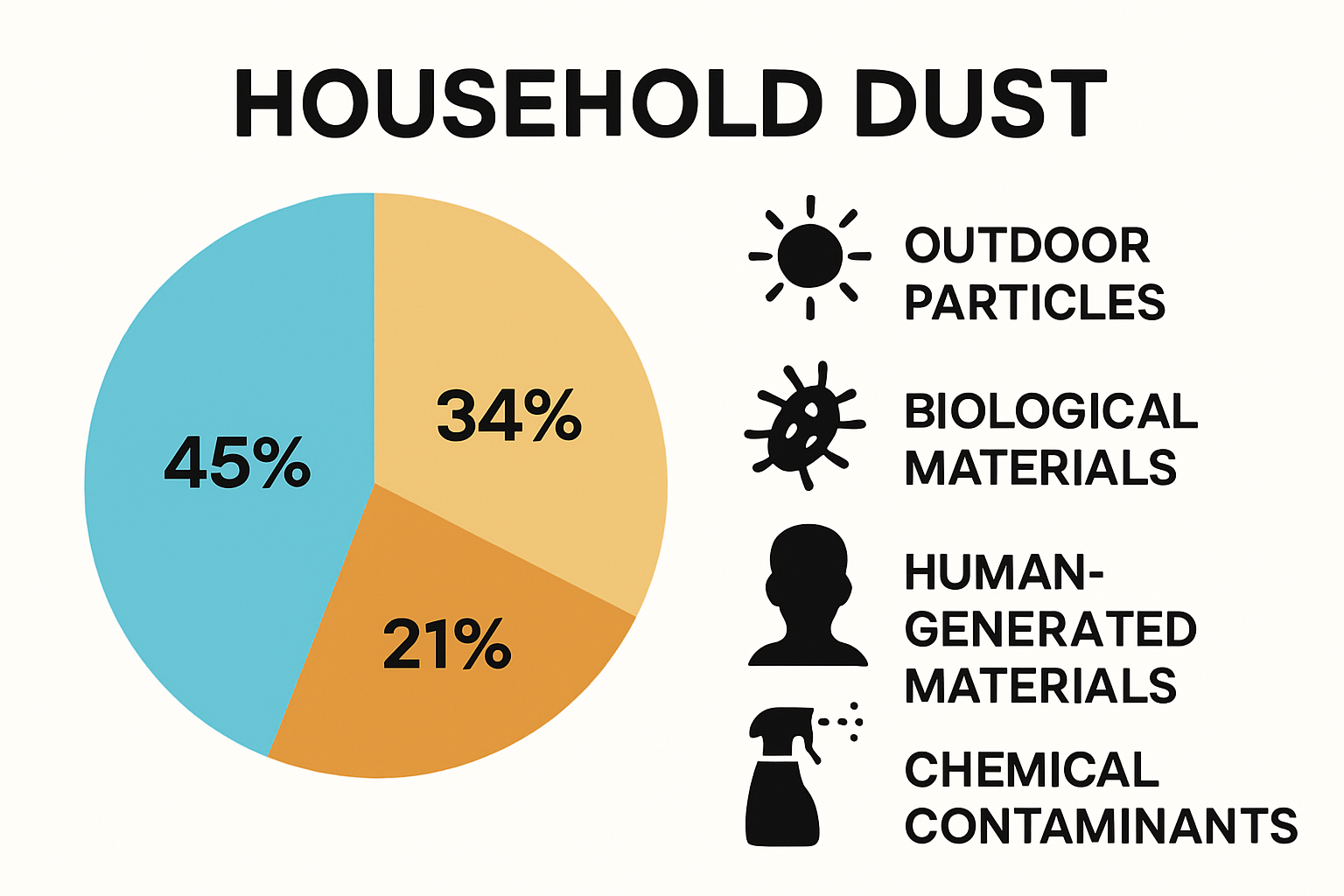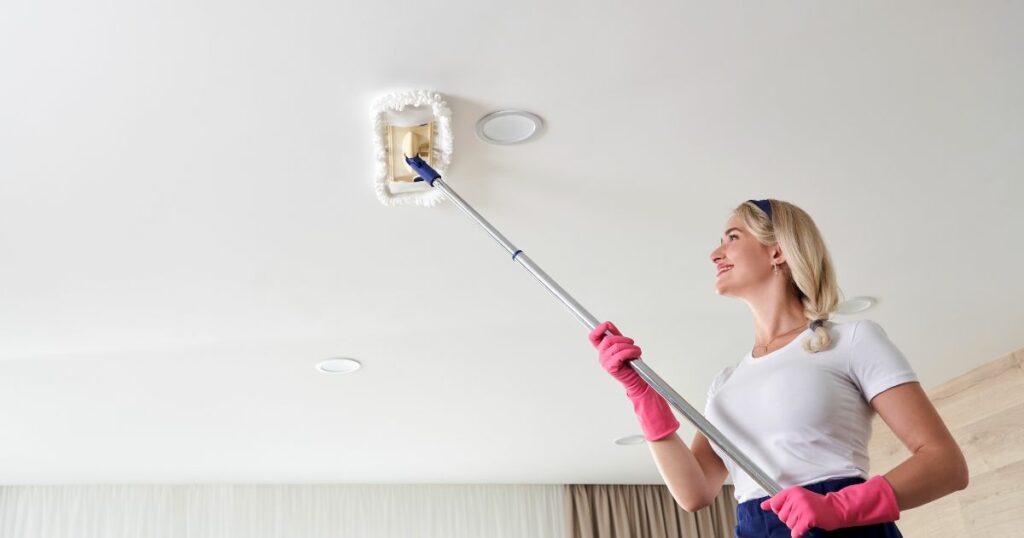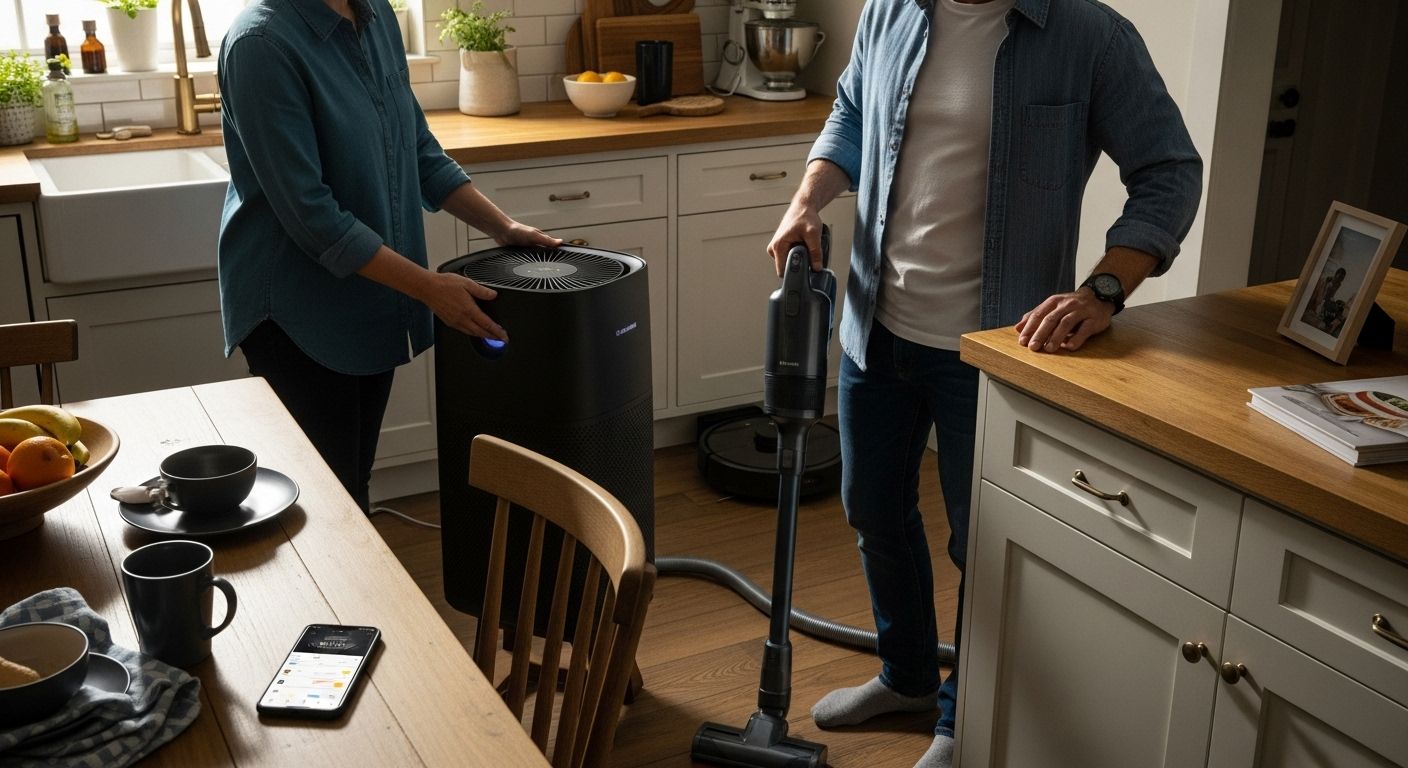Nobody wants to wake up to a thick layer of dust settling on every surface. Most people assume a quick swipe with a duster will fix it, but the truth goes much deeper. Indoor dust can be made up of up to 60 percent human skin cells and textile fibers, making your home a hidden breeding ground for tiny particles you cannot even see. There are smart strategies and unexpected upgrades that can cut down dust fast and actually make the air you breathe much cleaner. Learn the benefits and strategies for reducing dust in the home in this blog. Learn the benefits and strategies for reducing dust in the home in this blog.
Table of Contents: Reducing Dust in the Home
Quick Summary
| Takeaway | Explanation |
|---|---|
| Identify dust sources in your home | Understanding that dust comprises outdoor particles, biological materials, and human-generated components helps target your cleaning efforts effectively. |
| Establish a regular cleaning routine | Daily surface wiping and weekly bedding care can significantly minimize dust accumulation and improve indoor air quality. |
| Invest in HEPA air filtration systems | High-efficiency filters capture small particles, enhancing air quality and reducing dust presence throughout your home. |
| Employ smart cleaning technologies | Robotic vacuums and smart air purifiers provide automated solutions for consistent dust management and monitoring, making cleaning easier. |
| Tailor dust control to your property type | Adapting strategies for urban apartments, suburban homes, or newly built properties ensures effective dust reduction based on specific challenges. |
Common Causes of Excess Dust Indoors
Understanding the sources of indoor dust is crucial for effectively reducing dust in your home. Dust is not just a simple nuisance but a complex mixture of various particles that can significantly impact your indoor air quality and health.
The Composition of Indoor Dust
Contrary to popular belief, dust is far more than just dirt. Discover the hidden sources of dust in your home and you’ll be surprised by its intricate makeup. According to the U.S. Environmental Protection Agency, indoor dust comprises multiple components including:
Here’s a breakdown of the main components commonly found in indoor dust, summarizing their sources and impact on your home’s environment:
| Dust Component | Sources | Impact on Home Environment |
|---|---|---|
| Outdoor Particles | Soil, dust tracked in on shoes/in through windows | Increases general dust levels |
| Biological Materials | Pollen, mold spores, pet dander, dust mites | Allergens, can trigger respiratory issues |
| Human-Generated Particles | Dead skin cells, hair, textile fibers | Major contributor to dust accumulation |
| Chemical Contaminants | Flame retardants, pesticide residues | Potential indoor air pollution |
| Dust Mite Fragments/Droppings | Thrive in bedding, carpets, upholstery | Major allergen, worsen air quality |
- Outdoor Particles: Soil and dust tracked in from outside
- Biological Materials: Pollen, mold spores, pet dander, dust mites
- Human-Generated Particles: Dead skin cells, hair, textile fibers
- Chemical Contaminants: Flame retardants, pesticide residues
The American Lung Association reveals that dust mites play a particularly significant role in indoor dust composition. These microscopic creatures feed on dead skin cells and thrive in warm, humid environments like bedding, carpets, and upholstered furniture. Their body fragments and droppings constitute a substantial portion of household dust.

Environmental and Lifestyle Factors
Multiple environmental and lifestyle factors contribute to dust accumulation. Indoor activities such as cooking, burning candles, and using certain cleaning products generate particulate matter that settles throughout your living spaces. Home construction materials, including treated wood, carpets, and paint, continuously release microscopic particles into the air.
Pet ownership significantly increases dust levels. Animals shed fur and dander, which quickly disperses and settles on surfaces. Similarly, textile materials like curtains, rugs, and clothing constantly shed microscopic fibers that contribute to dust buildup.
HVAC and Ventilation Impact
Your home’s heating, ventilation, and air conditioning (HVAC) system plays a crucial role in dust distribution. Poorly maintained air filters and ductwork can become breeding grounds for dust and allergens. The EPA notes that combustion products from furnaces and inadequate ventilation can exacerbate indoor air pollution and dust accumulation.
Regular maintenance of HVAC systems, including frequent filter changes and professional duct cleaning, can significantly reduce the amount of dust circulating in your home. Understanding these common causes empowers homeowners to take proactive steps in reducing dust and improving overall indoor air quality.
Practical Cleaning Routines That Work
Effective dust reduction requires strategic and consistent cleaning approaches that target dust accumulation at its source. By implementing systematic cleaning routines, homeowners can significantly minimize dust buildup and maintain a healthier indoor environment.
Daily and Weekly Cleaning Strategies
Learn how to streamline your cleaning routine with targeted strategies that prevent dust from settling. Quick daily interventions can dramatically reduce long-term dust accumulation. Start by establishing a routine that includes:
- Surface Wiping: Use microfiber cloths to capture dust instead of spreading it around
- Floor Management: Sweep or vacuum high-traffic areas daily
- Bedding Care: Shake out and change bedding weekly to reduce dust mite habitats
The National Institutes of Health recommends using damp microfiber cloths, which trap dust particles more effectively than traditional dry dusting methods. Microfiber’s unique electrostatic properties attract and hold dust particles, preventing them from becoming airborne during cleaning.
Advanced Cleaning Techniques
Beyond basic surface cleaning, advanced techniques can provide deeper dust control. Invest in high-efficiency particulate air (HEPA) vacuum cleaners with sealed systems that prevent dust from escaping during cleaning. These specialized vacuums capture particles as small as 0.3 microns, significantly reducing airborne dust.
Consider implementing a zonal cleaning approach where different areas of your home receive targeted attention. Prioritize spaces like bedroom floors, living room surfaces, and home office areas where dust tends to accumulate more rapidly. Pay special attention to often-overlooked areas such as ceiling fans, top of door frames, and window sills.
Strategic Cleaning Tools and Approaches
Select cleaning tools designed specifically for dust mitigation. Electrostatic dusting cloths, extension-reach dusters, and specialized attachments for hard-to-reach areas can make dust removal more comprehensive. The Environmental Protection Agency recommends using MERV-rated air filters in your HVAC system, which can trap smaller dust particles more effectively.
Timing is crucial in dust management. Establish a consistent cleaning schedule that works with your lifestyle. Discover fun cleaning strategies that transform dust control from a tedious chore into an engaging activity. By making cleaning enjoyable and systematic, you’re more likely to maintain regular dust reduction practices.
Remember that effective dust management is about consistency and smart approaches. Regular, targeted cleaning prevents dust from becoming an overwhelming problem, creating a cleaner, healthier living environment with minimal effort.

Smart Home Upgrades for Dust Control
In the era of technological innovation, homeowners now have advanced solutions to combat dust beyond traditional cleaning methods. Smart home upgrades offer sophisticated strategies for reducing dust, improving air quality, and creating a healthier living environment.
Advanced Air Filtration Systems
Learn about cutting-edge dust control solutions that transform your home’s air quality. Modern smart air purifiers go far beyond basic filtration. These intelligent devices feature real-time air quality monitoring, automatic adjustment of filtration speeds, and connectivity with smartphone apps that provide comprehensive indoor air quality data.
The Environmental Protection Agency recommends high-efficiency particulate air (HEPA) filters that capture 99.97% of airborne particles as small as 0.3 microns. Smart air purifiers with true HEPA technology can remove dust mites, pet dander, pollen, and other microscopic pollutants effectively.
Key features of advanced air purification systems include:
The following table summarizes recommended dust-reducing features in advanced air purifiers, robotic vacuums, and smart home controls as discussed in this section:
| Technology | Key Features | Dust Control Benefits |
|---|---|---|
| Smart Air Purifiers | Smart sensors, auto mode, WiFi, filter change alerts | Removes microscopic dust/allergens, real-time air quality |
| Robotic Vacuums | Advanced mapping, HEPA filters, UV-C light (some models) | Automated cleaning, consistent floor dust reduction |
| Smart Controls | Air quality monitoring, humidity regulation, app control | Maintains optimal humidity, minimizes dust mite proliferation |
- Smart Sensors: Detect and measure particulate matter in real-time
- Auto Mode: Adjust filtration based on current air quality
- WiFi Connectivity: Allow remote monitoring and control
- Filter Change Alerts: Notify users when replacements are needed
Robotic Cleaning Technology
Robotic vacuum cleaners have revolutionized dust management. These intelligent devices use advanced mapping technologies, multiple filtration stages, and programmed cleaning routes to maintain consistently clean floors. Modern robotic vacuums can navigate complex home layouts, accessing hard-to-reach areas and providing consistent dust reduction.
The National Air Filtration Association highlights that advanced robotic vacuums with HEPA filtration can significantly reduce airborne dust particles. Some models feature UV-C light technology that helps eliminate microscopic organisms during the cleaning process.
Smart Home Environmental Controls
Integrated smart home systems now offer comprehensive dust control strategies. Smart thermostats and humidity controllers can help manage indoor environments that minimize dust accumulation. By maintaining optimal humidity levels between 30-50%, these systems reduce conditions favorable to dust mite proliferation.
When considering smart home upgrades, look for devices that offer:
- Real-time air quality monitoring
- Automatic humidity regulation
- HEPA filtration technologies
- Mobile app integration for comprehensive control
The GreenHome Institute emphasizes that smart home technologies are not just about convenience but about creating healthier living spaces. By investing in intelligent dust control solutions, homeowners can significantly improve indoor air quality and reduce potential health risks associated with airborne particles.
Smart home upgrades represent a proactive approach to dust management. These technologies offer continuous monitoring, automatic cleaning, and precise environmental control that traditional methods cannot match. While initial investments might seem substantial, the long-term benefits in health, comfort, and home maintenance make these solutions increasingly attractive for modern homeowners.
Reducing Dust for Different Property Types
Dust management strategies are not universal. Different property types present unique challenges that require tailored approaches to effectively control and minimize dust accumulation. Understanding the specific characteristics of your living space can help you develop a more targeted dust reduction strategy.
Urban Apartments and Compact Living Spaces
Learn how to tackle dust in challenging living environments where space is limited and external pollutants are more prevalent. Urban dwellers face distinct dust challenges due to proximity to street traffic, construction sites, and higher population density. The Environmental Working Group recommends implementing specific strategies for compact living spaces:
- Entrance Mats: Use high-quality, washable mats to trap incoming dust
- Air Purification: Invest in compact HEPA air purifiers designed for small spaces
- Minimal Furnishings: Choose streamlined furniture that reduces dust-collecting surfaces
- Regular Wet Cleaning: Use damp microfiber cloths to capture dust effectively
Urban apartments require more frequent cleaning due to higher dust infiltration from external sources. Consider using window screens with fine mesh to reduce dust entry and create a sealed indoor environment.
Suburban Homes and Larger Properties
Suburban properties present different dust management challenges, often involving more square footage and potential exposure to natural environments. The Housing for Health guide suggests comprehensive strategies for larger homes:
- Landscaping Considerations: Create buffer zones with concrete or gravel near home entrances
- Sealed Openings: Use weather stripping and seal potential dust entry points
- Vegetation Management: Maintain yards to reduce dust-generating ground surfaces
- HVAC Maintenance: Implement more rigorous air filter replacement schedules
Larger homes benefit from zonal cleaning approaches, where different areas receive targeted dust control based on their specific usage and dust accumulation patterns.
Specialized Properties: Renovations and New Constructions
Properties undergoing renovation or newly constructed homes face unique dust challenges. The Alaska Department of Environmental Conservation highlights the importance of proactive dust management during and after construction.
For newly built or renovated properties, consider:
- Temporary Barriers: Use plastic sheeting to isolate construction areas
- Advanced Filtration: Deploy industrial-grade air purifiers during and after renovation
- Thorough Initial Cleaning: Perform comprehensive dust removal before occupancy
- Material Selection: Choose low-dust generating materials and finishes
Each property type requires a nuanced approach to dust control. While the fundamental principles remain consistent, understanding your specific environment allows for more effective dust reduction strategies. By tailoring your cleaning and prevention methods to your property’s unique characteristics, you can create a cleaner, healthier living space with minimal ongoing effort.

Frequently Asked Questions
What are the main components of indoor dust?
Indoor dust is composed of various particles, including outdoor soil and dust, biological materials like pollen and pet dander, human-generated particles such as skin cells and textile fibers, and chemical contaminants like flame retardants.
How can I effectively reduce dust in my home?
To effectively reduce dust, establish a regular cleaning routine that includes daily surface wiping, weekly bedding care, and utilizing high-efficiency particulate air (HEPA) vacuums to capture fine particles. Incorporating smart air purifiers can also enhance air quality.
What is the role of HVAC systems in dust accumulation?
HVAC systems can contribute to dust accumulation if not properly maintained. Regular filter changes and professional duct cleaning are recommended to minimize dust circulation and improve indoor air quality.
How do robotic vacuums help with dust management?
Robotic vacuums utilize advanced mapping and filtration technology to clean floors automatically, reaching hard-to-access areas and consistently reducing dust throughout your home. They often include HEPA filters that trap fine dust particles effectively.
Ready to Breathe Easier in a Dust-Free Home?
If you are tired of battling stubborn dust no matter how often you clean, you are not alone. As this article explains, dust is not just an inconvenience. It is a mix of skin cells, pet dander, outdoor particles, and microscopic allergens that never truly disappear with surface wiping. Regular cleaning routines and advanced tools help, but dust can quickly return, especially in homes with pets or busy family members. For those struggling to keep up, professional help can make all the difference. Explore our House Cleaning solutions for personalized, deep-clean dust removal that protects your indoor air and your peace of mind.

Stop letting dust dictate your comfort. E.C. House Cleaning offers proven methods and over 20 years of experience to ensure real, lasting results. We use eco-friendly products and professional equipment for every job, with easy scheduling for busy homeowners. Ready to reclaim your clean? Request a free quote or book your cleaning today and experience a home environment where you can truly breathe easier.
Recommended
- Why Is My Newly Built House So Dusty? How to Get Rid of House Dust Forever
- How to Clean Dust after Renovation: Powerful Tips for Maintaining your Family’s Health
- Ultimate Parenting Cleaning Hacks: How To Keep a House Clean With Kids
- How to Keep a Clean House with Cats: 5 Powerful Strategies That Work
